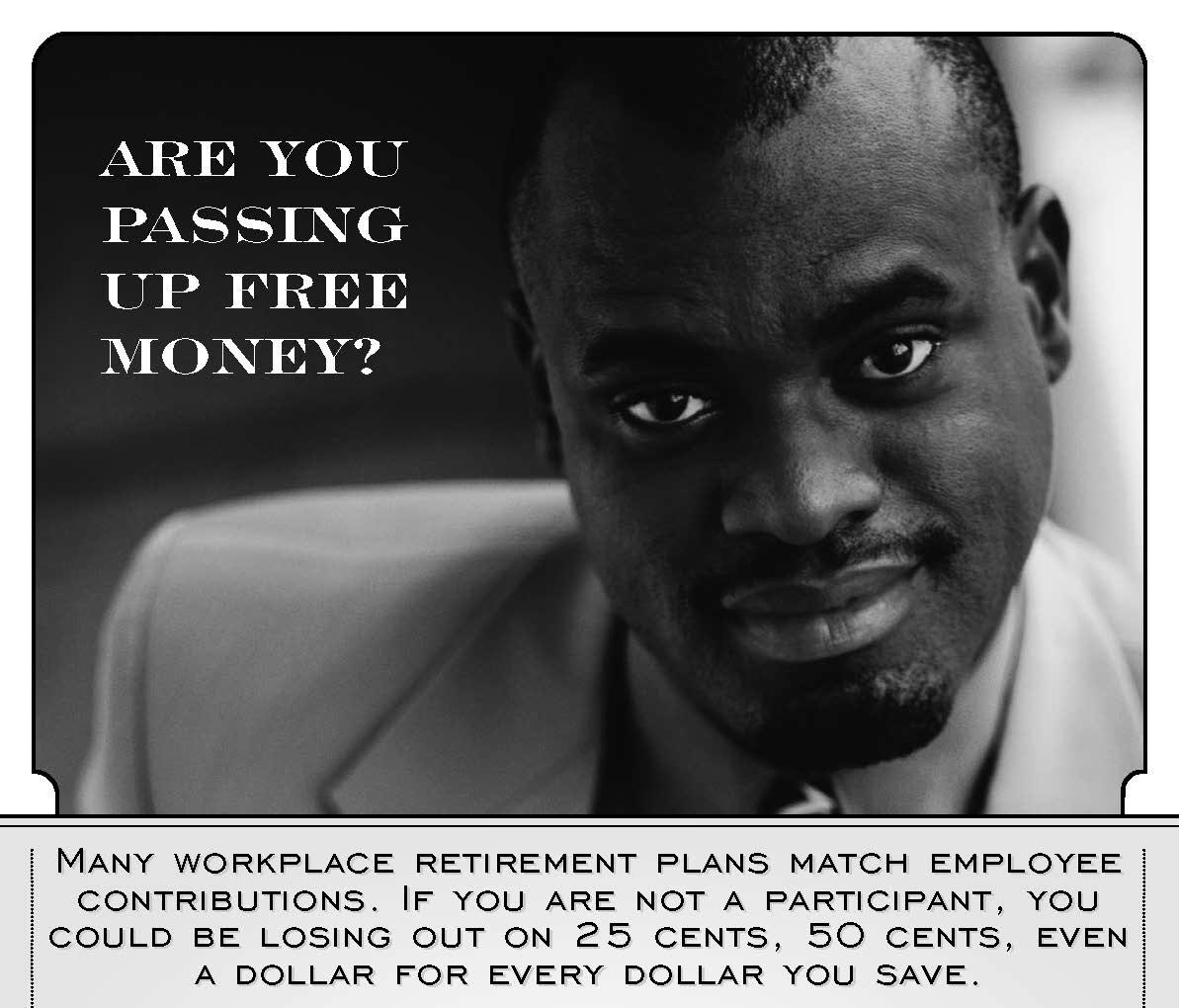Saving Matters
For Workers
New Job Entrants

It’s hard to get started, but it can really pay off. Whether you have just started working or are new to your current job, you may feel like you are not earning very much. In addition, there are many demands on your income: credit card debt, education loans, children, or even a mortgage. But if you start putting a little bit of money away each month, it will make a big difference to your future security. If you start now, with the Power of Compounding, you’ll have to save much less later on in your life, and you’ll be much better off financially.
If your employer offers a plan, find out how it works and make it work for you. If your employer has a 401(k) type plan and offers to put some money in if you do (called a match), this should be the first place that you save. Make sure you understand how a job change might affect your employer-based retirement plan and what your options are for saving that money.
If your employer does not offer a plan, you still have a number of good options. The important thing is to get started.
Reasons to Start Planning for Retirement While You Are Still Young
Retirement probably seems very far off, but here some very good reasons to start now:
- You’ll probably have to pay for more of your own retirement than earlier generations.
- You have one huge ally: time.
- You can start small and grow. Even setting aside a small portion of your paycheck each month will pay off in big dollars later.
- You can afford to invest more aggressively, which can have higher returns.
- Start the savings habit early!
New Job Entrants Resources |
Mid-Career

There are still some challenges, but you may have more resources now. You’ve been working for a few years and are taking on more responsibilities at work and at home. You may have bought a house or condo, or are saving to buy one. If you have children, you know how much time and money it takes to raise a family. It can be hard to focus on retirement planning, but you can make it part of your overall savings and money management plan.
If you have a workplace retirement plan be sure to find out how it works so that you can make the most of it. If there is a 401(k) or similar plan, find out how to how to participate. If your employer contributes, this is free money – don’t pass it up!
We also have information for you if you were in a plan at another job.
If your employer does not offer a plan, there are good savings options for you too. In fact, you probably also want to save on your own, even if you have a great plan at work, because most plans will not cover the full expenses of retirement.
Tips on How to Save Smart for Retirement
- Start now. Don’t wait. Time is critical.
- Start small, if necessary. Money may be tight, but even small amounts can make a big difference given enough time, the right kind of investments and tax-favored vehicles such as company retirement plans, IRAs, and SEPs.
- Use automatic deductions from your payroll or your checking account for deposit in mutual funds, IRAs, or other investment vehicles.
- Save regularly. Make saving for retirement a habit.
- Be realistic about investment returns. Never assume that a year or two of high market returns will continue indefinitely. The same goes for market declines.
- If you change jobs, keep your retirement account money in your former employer's plan or roll it over into your new employer's plan or an IRA.
- Don’t dip into retirement savings.
Mid-Career Resources |
Near Retirement

You’re more motivated to save now, just stay focused. At this point in your career, retirement no longer seems so far off. There are, however, still many demands on your time and your income, including children and parents to care for, responsibilities at your job, a mortgage. It can be hard to find the time and money for retirement planning, and the task can seem daunting. But retirement can also be a time of new beginnings, especially if you are properly prepared. We’re here to help you stop worrying and start planning.
If your employer offers a plan, take advantage of it. There is still time to build retirement savings. If you’re thinking about changing jobs, find out how that might affect your employer-based retirement plan and what your options are.
If you were in a plan at another job, make sure you know what benefits you may be able to receive from it and how.
How To Prepare When There’s Little Time
- Sock it away. Put everything you can into your tax-sheltered retirement plans and personal savings. Try to put away at least 20 percent of your income.
- Reduce expenses. Funnel the savings into your nest egg.
- Take a second job or work extra hours.
- Aim for high returns. Don’t invest in anything you are uncomfortable with, but see if you can’t squeeze out better returns.
- Retire later. You may not need to work full-time beyond your planned retirement age. Part-time may be enough.
- Refine your goal. You may have to live a less expensive lifestyle in retirement.
- Delay taking Social Security. Benefits will be higher when you start taking them.
- Make use of your home. Rent out a room or move to a less expensive home and save the profits.
Near Retirement Resources |
In Retirement
Your hard work and planning are paying off. You have worked hard and saved faithfully, and you know the importance of having a plan. If you were in the workforce at some point, you may be able to receive a benefit from a pension or an employer-based retirement plan.
Some of you may still be working part-time, and can still save towards retirement, or supplement your retirement income. If you haven’t already, track down any benefits you might be able to receive from previous employers. Now more than ever before, it’s important that you understand how your employer’s plan works and what benefits you will receive in retirement from any possible sources.
In Retirement Resources |
The Power of Compounding
Even small investments become larger investments if you leave them there over time, and let the interest compound and grow.
How It Works
The money you save in a savings account, in your 401(k) plan, mutual funds or other accounts, earns interest or investment earnings. When you leave money there, over time you also earn interest on your interest, or earnings on your earnings. Although this sounds like a slow process, when you start early it can result in some amazing growth in your money over the long haul.
For example:
A 20 year old who saves $1,000 a year for 11 years in a row, then stops but leaves it there to earn 7% interest, will have $168,514 at age 65.
However, a 30 year old who starts saving $1,000 a year for 35 years, also earning 7% will have only $147,913 at age 65. Even though the 30 year old has put in more money for more years, it has less time to earn that compound interest.
Here are some additional examples of how $1,000 is compounded over time, and at different interest rates. Clearly, more time and higher interest rates both help your money grow.
10 |
$1,481 |
$1,791 |
$2,159 |
$2,994 |
20 |
$2,191 |
$3,207 |
$4,661 |
$6,728 |
30 |
$3,243 |
$5,743 |
$10,063 |
$17,449 |
My Employer Offers a Retirement Plan

If your employer offers a retirement plan, many retirement experts say you should take advantage of it. The first step is to understand what type of plan it is, and how it works.
Some employers offer a traditional pension plan, sometimes called a defined benefit plan. In this type of plan, the employer makes the contributions and promises the participant a specified monthly benefit at retirement. Often, the benefit is based on factors such as the employee’s salary, age, and the number of years worked for the employer. You may need to stay a certain number of years before you are eligible to receive any benefits.
If your employer offers a defined contribution retirement plan, like a 401(k) plan, you may have to make the decision to participate. As part of that decision, you choose how much to have deducted from your paycheck. Some employers have automatic enrollment 401(k) plans so that you are automatically signed up for the plan unless you opt out. Whether you are automatically enrolled or sign up yourself, try to contribute as much as you can.
Often your contributions are matched up to a set percentage by your employer. If your employer provides this type of match, make sure your contribution is enough to get the employer’s match; don’t pass up free money for your retirement savings. Your contributions are deducted from your salary pre-tax, and the investment grows tax deferred until you take it out of the plan. Follow these and other tips for protecting and maintaining your 401(k) savings to watch your retirement savings grow.
Savings Fitness: A Guide to Your Money and Your Financial Future has great information on how these plans fit into your overall financial plan. In addition, the Department of Labor publication What You Should Know About Your Retirement Plan explains different types of plans and how they work, including what to do if you have a problem.
If you work for a private company plan and are in an employee benefit plan that falls under the protection of the Employee Retirement Income Security Act of 1974, you have certain rights if your claim for benefits is denied. We have consumer retirement plan information that can help you understand your retirement plan.
My Employer Does Not Offer a Retirement Plan
If your employer does not offer a retirement plan, you still have a number of options.
First, you can encourage your employer to offer a plan. Many employers are not aware of the benefits to be gained by offering a plan and the different options that are available. Our publication Choosing a Retirement Solution for Your Small Business explains that it may be easier to start a plan than many people think.
Second, if you are job hunting, you may find a position with an employer that offers a retirement plan. If two jobs offer similar pay and working conditions, the job that offers retirement benefits may be a better choice when you consider the benefit as extra money for you down the road.
Finally, you can save on your own. One option is to open an IRA, an Individual Retirement Account. An IRA is a personal account that you set up with a financial institution, like a bank or a mutual fund company. It’s easy to start. You can send a check to the financial institution or have a certain amount deducted regularly from your checking or savings account, or from your paycheck.
There are two different types of IRAs, traditional and Roth IRAs, which offer different tax advantages. It can be difficult to determine absolutely which one will provide the greater tax advantages for any one person because it requires predicting what your tax bracket will be when you retire. So do some research and then take your best guess. There are income limits and limits on how much you can contribute to an IRA each year. But for many of us, the problem is that money is tight. Keep in mind that you can start with a small amount and then increase it later. The important thing is to get started.
Even if your employer offers a plan, it’s still a good idea to save in both the employer plan and on your own, in mutual funds, stocks, bonds, U.S. Savings Bonds, real estate, certificates of deposit, or other assets.
Whether you are saving through an employer plan or on your own, it is always important to manage your retirement savings. Savings Fitness: A Guide to Your Money and Your Financial Future has information on saving for retirement and other events in your life, including what to do if you can't join an employer-based plan (on page 23) and managing for a lifetime of financial growth (on page 27).
I Was Enrolled in a Plan in the Past
If you have changed jobs in the past, you may be owed retirement benefits by a previous employer – that is, if you did not withdraw the funds when you left the job.
Think about your past employers and any retirement plans in which you may have been enrolled. If a past employer owes you a pension or other retirement benefit, you should be receiving statements in the mail about your account. If not, the employer or plan administrator may not know how to contact you – try to contact them to update your information. They should be able to send you a Summary Plan Document and your most recent individual benefit statement or a letter listing your benefits.
If you encounter difficulty in contacting the employer or plan administrator, the Pension Benefit Guaranty Corporation’s publication Finding a Lost Pension may be of help. Another reason that you are not receiving mailings could be that the plan administrator “abandoned” the plan – leaving no one with the authority to operate the plan. If you believe this may be your case and your plan was a defined benefit plan, contact the Pension Benefit Guaranty Corporation. In addition, the Department of Labor has a resource that will let you search for an abandoned plan.
If you worked for a company that terminated its defined benefit plan due to bankruptcy, you may be entitled to benefits as well. See the Department of Labor’s fact sheet, Your Employer's Bankruptcy: How Will It Affect Your Employee Benefits? or the Pension Benefit Guaranty Corporation’s Your Guaranteed Pension for information and procedures for obtaining help.
Secure Your Financial Future: A Toolkit for People with Disabilities

If you are looking to secure your financial future, you are not alone.
As the job market changes, many people — including people with disabilities — will be making employment–related decisions based on their new financial situation. You may be one of them.
The financial toolkit is an up-to-date repository of financial literacy tools and resources beneficial to all Americans, including individuals from historically underserved populations, striving to achieve financial stability. We all need clear and accurate information to secure our financial well-being.
The toolkit provides a path forward based on where you are in your employment journey. Choose any of the topic areas below — Preparing for a Job, Starting a Job, Maintaining a Job, Changing or Losing a Job, and Retiring from a Job — for answers to important questions, including tools and resources to help you meet your financial goals.
